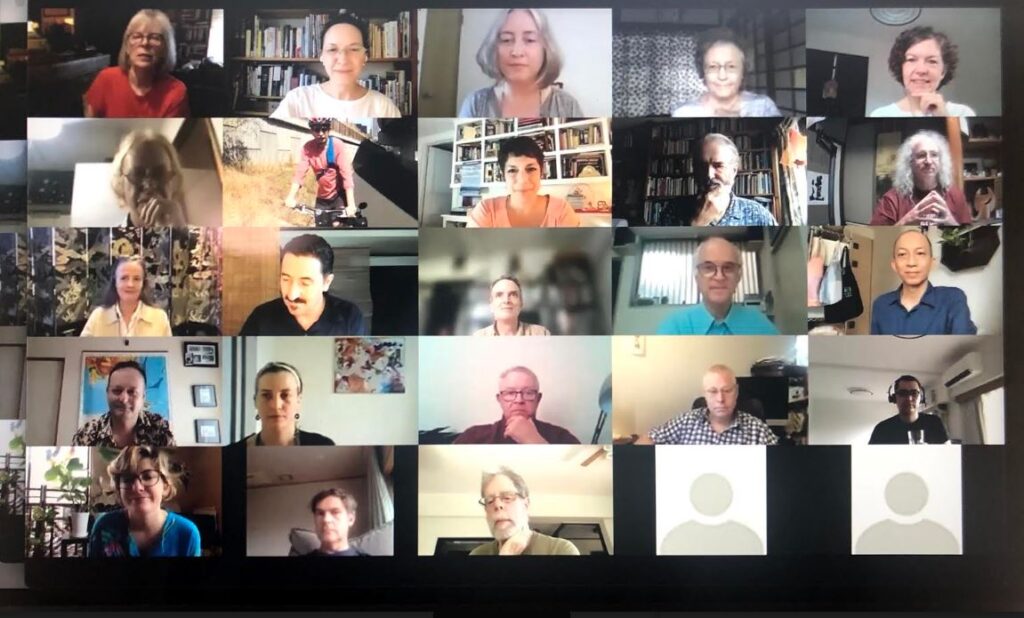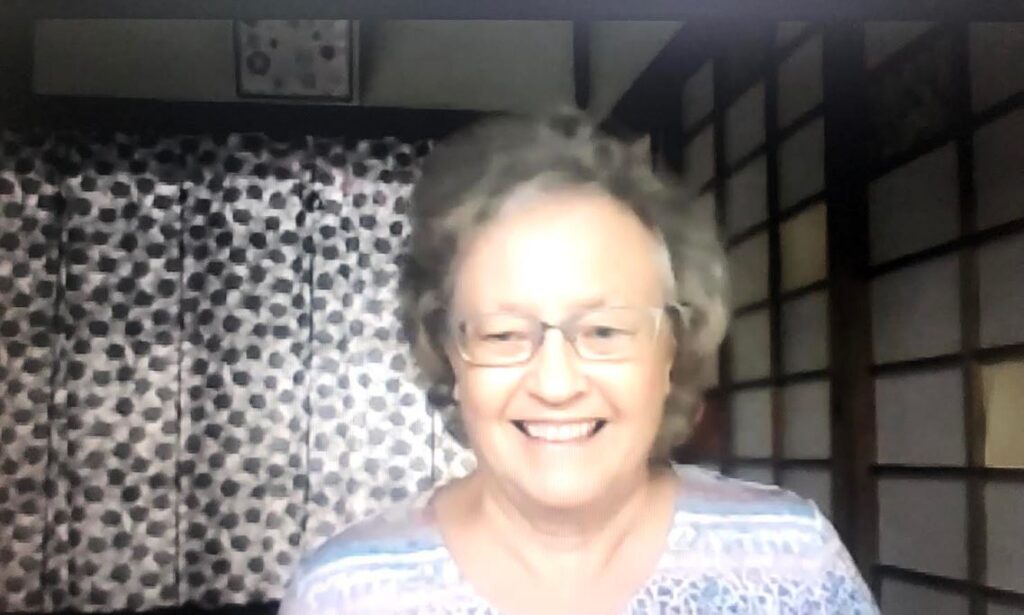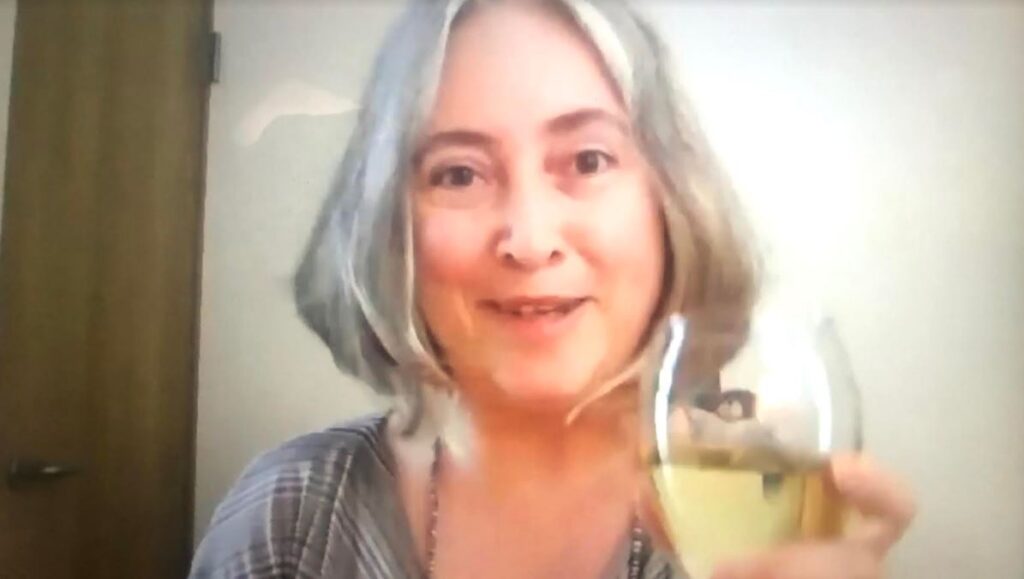On August 22, 2021 Writers in Kyoto launched its fourth anthology, Structures of Kyoto. One blessing in this difficult year has been how technology has bridged the distance gap. We had attendees from across the globe tuning in from different time zones, some just waking, some staying up late, all happy to be sharing this moment honoring a special book.
Lisa Wilcut, our Zoom host, opened our event with the agenda for the evening and passed the microphone to the editors. Rebecca Otowa thanked the contributors and all those involved in bringing the anthology to print, especially John Dougill and her co-editor Karen Lee Tawarayama. She extended her thanks to the editors of prior anthologies with special recognition to Jann Williams, the chief editor of Encounters with Kyoto (WiK Anthology 3), for all of her guidance and encouragement. She also expressed her gratitude to Rick Elizaga for formatting the publication and acting as Amazon liaison, and to the illustrators, Stuart Ayre (who created the cover picture and other illustrations), Karina Takata (who illustrated the 100 Poems translations on the section head pages) and Sharon Sandberg (who provided illustrations in Karen Lee Tawarayama’s story “The Life Dispensary”).
Kyoto has many physical, as well as cultural, social and psychological structures. Rebecca explained that she chose the theme of structures because of its broad scope and potential for variety. Indeed, the variety can be witnessed in the anthology, especially in the organization of the book itself. The order of contributions is aligned with the map of Kyoto from West to East so that the interconnections between the pieces become even more apparent.
Karen Lee Tawarayama offered special thanks to Rebecca for guiding her in the co-editing process. She led a toast to all the contributors and the previous editors and passed the microphone to John Dougill, the founder of WiK. John joined us from Hokkaido and commented on the evolution of the organization. He reminisced about starting as a small group around a table in Kyoto and marveled at how we have grown into a large international membership. We are now “writers whose hearts are in Kyoto.” John shared how he prefers to write in coffee houses, away from the distractions calling for his attention at home. In his anthology essay “Three Literary Cafes”, he describes his experience based on places associated with the Beats, Cid Corman and Pico Iyer.
In her foreword to the anthology, Judith Clancy reflects on her fifty years in Kyoto and the evolution of the writing community. Judith was unable to join us but sent a message of gratitude to all involved with the publication.
The contributors then talked about their pieces in the order of the Table of Contents. The first contributors were Rona Conti and Brenda Yates, who unfortunately could not join us. Rona’s essay “What Does This Say, Sensei?” addresses her experiences learning Japanese culture through calligraphy. Brenda Yates was the third prize winner of the 2020 WiK Kyoto Writing Competition with “Interlude: Kyoto,” a beautiful poem on the four seasons in Kyoto.
With a diorama of Ryōan-ji garden in one hand, Mark Hovane explained that his essay “Rocks, Gravel, and a Bit of Moss” is about Kyoto’s invitation to forge new ways of seeing, how Kyoto challenges our structures of perception.
Amanda Huggins could not join us, but her contribution “Sparrow Steps” won Second Prize in the 2020 WiK Kyoto Writing Competition. She conjures up the city in this delicate piece about a precarious relationship.
Rebecca Otowa spoke about “Structures of Tea” and her personal, poetic, and aesthetic relationship to the tea ceremony and how it has the power to transcend ordinary sensations.
The banks of the Horikawa was the first place where Felicity Tillack felt a sense of community in her new home of Kyoto. She shared an experience from her first year, when her young students held a regatta of homemade boats on the Horikawa and how it inspired her to write “The River.”
Mike Freiling thanked Karina Takata for the illustrations that accompanied his translations of the Hyaku Nin Isshu. He read from those and from his own poems, “The Streets of Miyako.”

“Sunrise Over the Kamogawa” by Ina Sanjana won Second Prize in the 2019 WiK Kyoto Writing Competition. Ina wrote this poignant poem about a homeless man as a way to highlight a part of Kyoto that is not often witnessed.
Karen Lee Tawarayama discussed her story “The Life Dispensary” about a mythological creature’s attempt to survive climate change in a future version of Kyoto. Her striking story is illustrated by Sharon Sandberg who joined us from Michigan.
Robert Weis, who could not join us, wrote “Converging Waters: Kamogawa Delta Blues” using the delta shape of the Kamo River as symbolic of life choices.
Kyoto is a city of training structures and Reggie Pawle, speaking about his piece “The Magic of the Training Structures of Zen and Kyoto”, explained how the adherence to the structures allows one to reach the heights of mastery, then understanding (as well as pleasure), and eventually freedom.
“December” won Lauren E. Walker the First Prize in the 2020 WiK Kyoto Writing Competition. Lauren explained how she tried to capture the magic of Kyoto through a long walk from Kawaramachi to Ohara. Lauren’s discussion led us in to Edward Taylor’s “Ohara, After Scarlet Leaves.” Edward discussed the themes of impermanence and decay.
Jann Williams could not join us to discuss her fascinating piece “Beyond Zen: Kyoto’s Gorinto Connections,” an essay on the subject of Kyoto’s Buddhist Gorinto monuments.
The 2019 WiK Kyoto Writing Competition First Prize went to Lisa Wilcut for her atmospheric poem “Okuribi” about the send-off of ancestors at the end of Obon. Simon Rowe tuned in from Himeji and followed Lisa with a tale of two reluctant outlaws executing an escape using the festivities of Obon and the Daimonji fire as cover. Both Lisa and Simon expressed admiration for each other’s ability to capture the energy of that special evening.
Catherine Pawasarat had to sign off before she was able to share thoughts on her essay “The Gion Festival: A Hero’s Journey”, in which she poses such interesting questions such as “If we are present for a purification ritual but don’t know it’s happening, does the ritual still affect us?”
The photographs of John Einarsen and his short piece “The Gate” are a perfect respite from heady philosophical questions. John could not attend, but his photos of Nanzen-ji gate speak for themselves. They are lovely in the paperback edition and even more beautifully rendered in the e-book version.
Robert Yellin shared some ceramic pieces of various styles on screen and reminded us that touching them can be a way to connect with nature. He discussed his essay “A Kyoto Ceramic Dynasty”, about the eight generations of Kiyomizu Rokubey family ceramics.
Ken Rodgers, in “Sanjusangendo, Reinterpreted”, spoke on imagined structures. He shared 17th century illustrations of Sanjusangen-do created by Westerners guided by the written descriptions found in Dutch merchants’ accounts from their travels to Kyoto.
We learned that the 450-year-old candy shop located behind Kennin-ji and their “candy for raising children” was the inspiration for Marianne Kimura’s story “Yurei Ame/Ghost Candy”, for which she received Third Prize in the 2019 WiK Kyoto Writing Competition.
In closing, Alex Kerr spoke on “A New Philosophy of Tourism.” He believes Kyoto’s future is bound up in how over-tourism will be handled post-Covid.
We wrapped up the event with questions and further discussion as we sipped our cocktails and coffee.
In a time when Kyoto is inaccessible to many of us, this anthology has the power to transport us back to the city we love. The power of words and the power of technology worked hand in hand to bring us together and to honor the city WiK calls home. Our hearts are in Kyoto regardless of where we find ourselves on the globe.
We look forward to the next edition. There is no more appropriate way to end than with Karen Lee Tawarayama’s toast, “May Writers in Kyoto prosper, and may we all continue to inspire each other.”
Contributed by WiK member Tina deBellegarde, a novelist and short fiction writer. Tina lives in New York and joined Writers in Kyoto in 2020. Her poem “Sound Travels” won the USA Prize in the 2021 WiK Kyoto Writing Competition.



